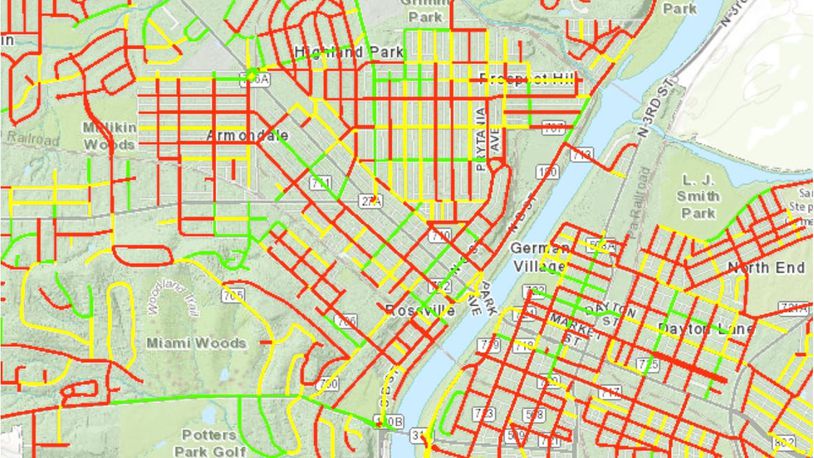• The preferred method is to visit hamilton-oh.gov/streetslevy, which includes an interactive map that shows the condition of specific streets as rated by third-party consultants.
The condition scores vary block by block, and citizens can see each score by zooming in on the map. Residents then can choose stretches of the streets they want paved by picking the street and then an intersection, which will indicate about a block in either direction.
• Another way is to call the Street Levy Feedback line at 513-785-7155. It is available 24 hours a day and goes directly to voice mail. People can leave their name, address, phone number or email and suggest up to three streets they want to see paved, and preferably the sections of the street they most want to see receive new asphalt.
• Also, information will go out with city utility bills that have a box for each of the three streets someone is advocating, along with the nearest cross street to the area they most want paved.
The city will collect residents’ feedback all year long, but for input on street paving to be considered for 2021 work, feedback is needed by Aug. 7, city Director of Neighborhoods Brandon Saurber told Hamilton City Council this week.
That deadline “ensures that our engineers have time to review that input, scope out the projects so that we can bid them out by the end of the year and have everything ready to go in January of 2021 for the 2021 paving season,” he said.
City Director of Engineering Rich Engle said that with about $6.1 million to spend, compared to $1.5 million in past years — before the street levy and an increase in license-plate stickers — the city should be able to pave a total of “about 35 lane miles” per year. For comparison, “we typically do about 9 lane miles per year,” he said.
The $5-per-year license-tag fee, which council approved last year, generates about $300,000 annually, while the 3.9-mill streets levy adds about $3.1 million a year to paving programs. The city also receives additional money from the state as its share of the gasoline taxes that Ohio increased by 10.5 cents per gallon in early 2019.
Not all of Hamilton’s 17 neighborhoods will not see paving next year, Saurber said, although each neighborhood will see its proportional share of paving during the next decade.
For example, if one neighborhood has 6 percent of of the city’s streets, the city has promised it will receive approximately 6 percent of the levy funds over the 10 years.
“Likely, when you see paving activity in your neighborhood, it’s going to be concentrated to about a 1-3-year period,” Saurber said. “And the reason for that is that some of the paving projects that are smaller, it can actually cost more to mobilize the equipment from one end of town to the other one, than the actual paving itself.”
That’s why staff will try to cluster projects closer together, he said.
Casey Hume, a Rossville neighborhood resident who last year ran for City Council and differed with the type of property tax the city proposed, said he likes the way Hamilton officials are going about gathering input.
“I do plan on submitting my suggestions,” Hume said. “I do agree with the way they are going about getting the information. We do have a lot of streets that need to be taken care of. I’m just hoping they really take into account the age of some of these roads,” not strictly peoples’ input, “because you might get a lot of input from one area, and none from another.”
The city each year will produce an annual report showing the input received and how that input led to street selections.
The additional money won’t fix everything, city officials explained before the levy vote. That’s because Hamilton has has 250 miles of streets, but when multiple lanes are added together, Hamilton has 550 miles of street lanes.
“I was impressed with how the Department of Neighborhoods has rolled out the survey, and the various ways that despite COVID-19, we are able to get our citizens’ input on which streets should be paved,” said Mayor Pat Moeller said.
“There’s the telephone number, there is the online, there is what people will be receiving in their utility bills on how to cast their opinion. And I don’t know any other city that’s done this, myself, but to have the citizens be part of the solution this much is great.”
He added: “I love seeing this type of citizen input, really, where the pavement meets the road.”
Street-Paving Factors
Here are some factors, aside from public input, that Hamilton officials have to consider when deciding which streets to pave, and when:
- The city with its online mapping that residents can use to see consultants' evaluations of area streets shows those in worst condition as red, those not quite as bad as yellow, and those in the best shape as green. Here's one factor about fixing the red streets: "These are the streets that are in the most dire need of repairs but also require the most money to do so because of the scope of work needed," according to the city website.
- When a street is paved may depend on utility construction or other work in the area that is planned for the future, because it is wasteful to pave a new stretch of roadway and then dig it up, unless the digging couldn't have been foreseen.
- Traffic volume is another consideration. A cul-de-sac is far less likely to receive paving priority compared to a street with heavy traffic.
- Streets considered "worst of the worst" will receive priority if they're a danger to people, as will streets approaching thresholds where "deterioration is expected to speed up exponentially."
About the Author
